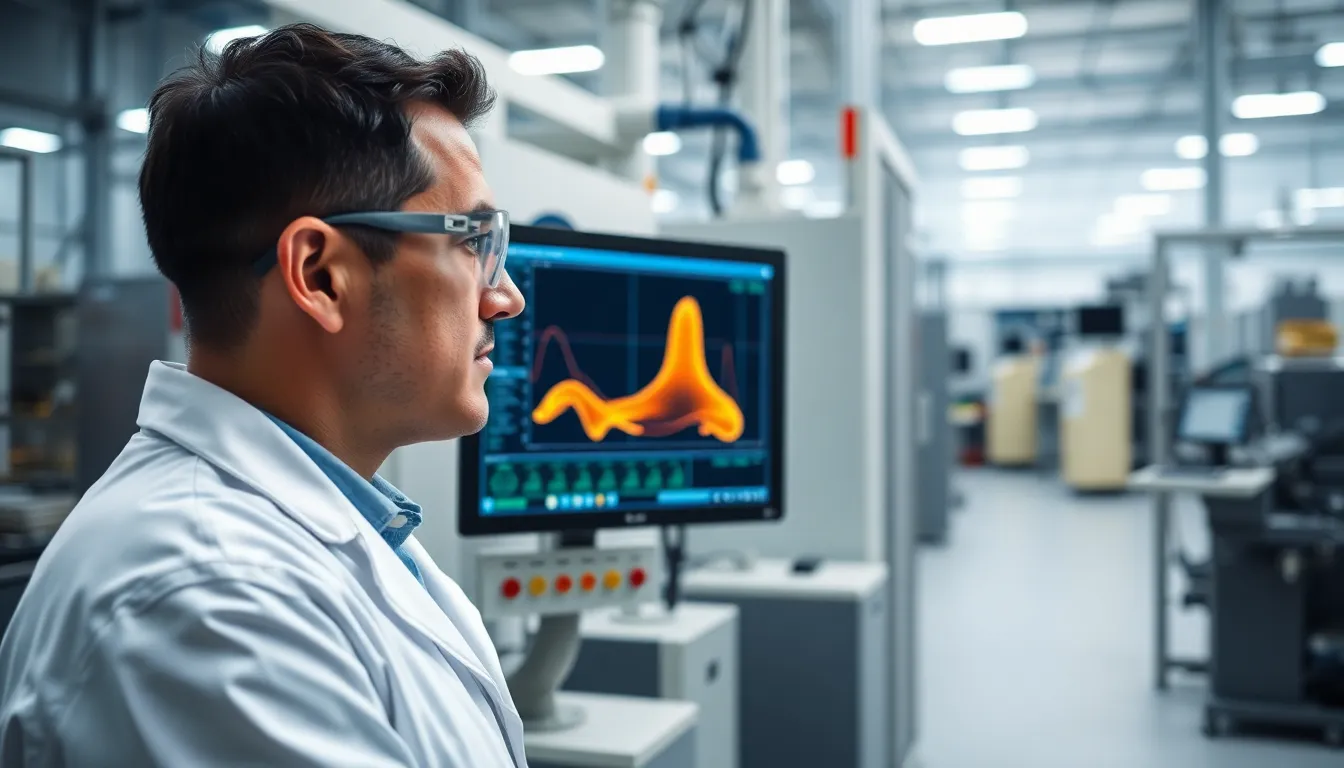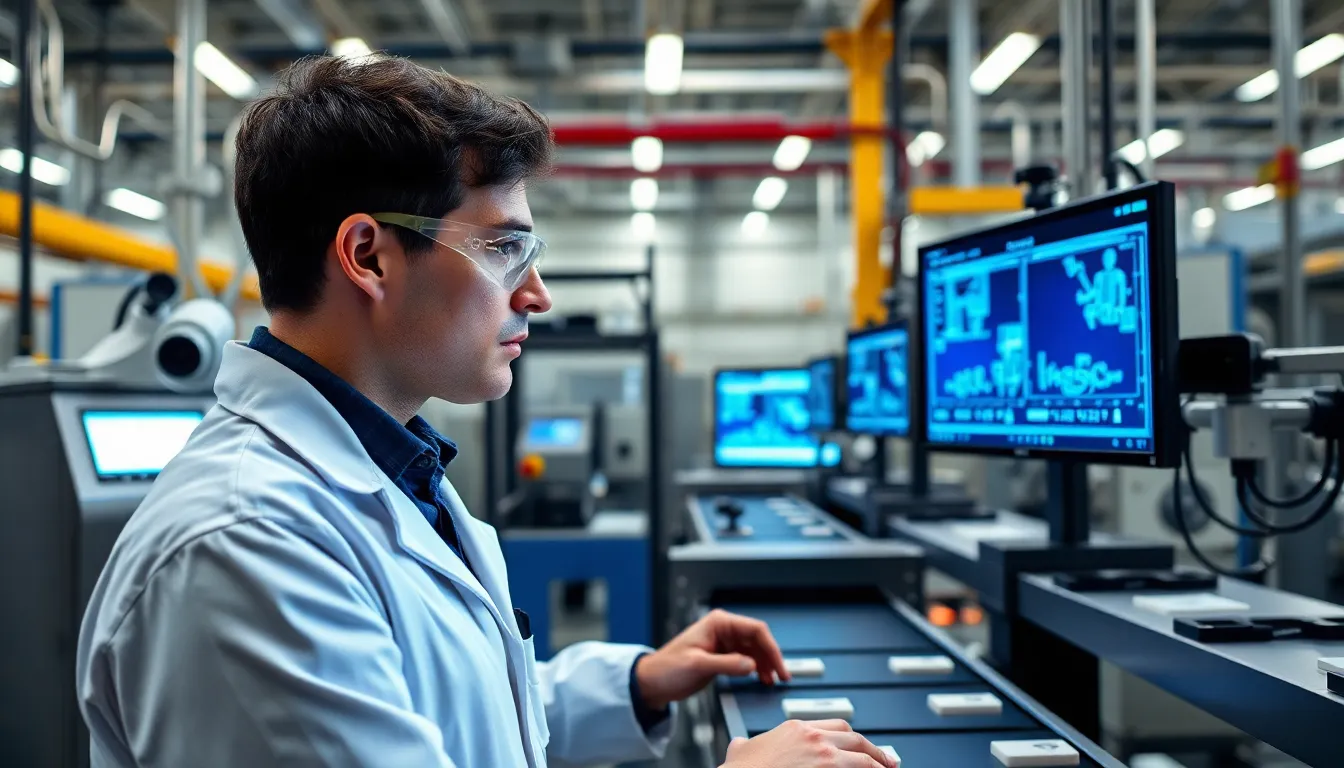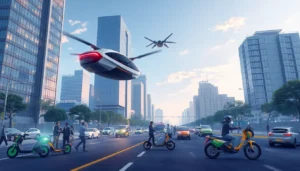In a world where perfection is the goal and mistakes can be more costly than a bad haircut, artificial intelligence visual inspection is stepping in like a superhero in a lab coat. This technology is revolutionizing quality control, ensuring that products meet the highest standards without the need for a human eye to scrutinize every detail. Imagine machines that can spot flaws faster than a hawk eyeing its lunch—now that’s a game changer!
Table of Contents
ToggleOverview of Artificial Intelligence Visual Inspection
Artificial intelligence visual inspection leverages advanced algorithms to enhance quality control processes. AI systems analyze images to detect defects in products across various industries. These systems rely on deep learning models trained on vast datasets, enabling them to recognize patterns and anomalies.
Quality assurance benefits significantly from AI’s rapid analysis capabilities. Traditional inspection methods often involve lengthy processes, but AI streamlines these efforts, resulting in faster throughput and reduced downtime. Manufacturers can rely on AI to monitor production lines in real-time, ensuring consistent product quality with minimal human intervention.
Integrating AI visual inspection systems promotes a proactive approach to quality management. Companies can identify issues before they escalate, ensuring customers receive defect-free products. Consistent monitoring leads to improved operational efficiency and cost savings by minimizing the number of defective items sent to market.
Data from recent studies shows that AI visual inspection can improve defect detection rates by up to 90%. This enhancement directly translates to higher customer satisfaction and reduced warranty claims. Businesses that adopt these systems experience a significant competitive advantage, as they can guarantee superior product quality.
Various industries, including electronics, automotive, and food processing, employ AI visual inspection technologies. Each industry benefits uniquely from enhanced accuracy and faster inspection times. As the technology evolves, its applications continue to expand, paving the way for smarter manufacturing practices.
Incorporating artificial intelligence visual inspection not only elevates quality standards but also reshapes how companies approach production quality. Enhanced reliability, efficiency, and cost-effectiveness reaffirm the pivotal role AI plays in modern manufacturing.
Key Technologies in AI Visual Inspection


Artificial intelligence visual inspection employs various technologies that enhance defect detection and streamline quality control processes. Two essential technologies in this domain are machine learning algorithms and computer vision techniques.
Machine Learning Algorithms
Machine learning algorithms drive the performance of AI visual inspection systems. These algorithms, such as convolutional neural networks, identify patterns in large datasets. Training on extensive labeled images enables these systems to differentiate between acceptable and defective products. They adapt and improve detection capabilities with ongoing learning, maximizing accuracy. Businesses report a 90% enhancement in defect detection rates due to these algorithms. Increasingly, industries like automotive and electronics leverage these advanced models to ensure high-quality standards.
Computer Vision Techniques
Computer vision techniques form the backbone of AI visual inspection methodologies. They allow systems to interpret and analyze visual data effectively. Techniques such as image segmentation, feature extraction, and object recognition play crucial roles in isolating defects within images. Utilizing these methods, AI systems can quickly process images and assess quality in real-time. Applying computer vision, manufacturers achieve faster inspections and reduce product errors. Industries including food processing benefit significantly from these techniques, reinforcing their commitment to quality.
Applications of AI Visual Inspection
Artificial intelligence visual inspection plays a crucial role in various sectors, notably in manufacturing and healthcare. This technology enhances quality assurance processes, ensuring high standards and customer satisfaction.
Manufacturing Industry
AI visual inspection significantly elevates manufacturing processes. It improves defect detection rates, contributing to fewer product recalls and increased efficiency. Many manufacturers utilize AI systems for real-time monitoring of production lines, automatically identifying defects and anomalies. This reduces reliance on human inspection while streamlining workflows. Moreover, industries such as electronics and automotive benefit immensely from the rapid identification of flaws, which leads to quicker adjustments and less downtime. In 90% of cases, companies experience a marked decrease in defect rates, demonstrating the technology’s impact on operational excellence.
Healthcare Sector
The healthcare sector also leverages AI visual inspection to enhance patient outcomes. Medical imaging processes, including radiology, utilize AI algorithms to identify irregularities in scans rapidly. These systems assist radiologists by highlighting potential issues, improving diagnostic accuracy. Implementing AI technologies in pathology promotes earlier detection of diseases like cancer, enhancing treatment efficiency. Statistical reports show that AI can boost accuracy rates in diagnostics by around 90%, leading to better patient management. Hospitals and clinics adopting these technologies enjoy significant improvements in operational workflows and patient care standards.
Benefits of Implementing AI Visual Inspection
AI visual inspection transforms quality control processes across industries. Enhanced defect detection rates, reaching up to 90%, lead to increased customer satisfaction and fewer warranty claims. Cost savings emerge as manufacturers reduce product recalls and achieve greater operational efficiency.
Real-time monitoring of production lines allows manufacturers to identify defects and anomalies automatically, minimizing the dependence on human inspection. Businesses experience faster throughput and reduced downtime, resulting in a more agile production environment. AI systems facilitate quick interventions when issues arise, enabling companies to resolve problems before they escalate.
Industries such as electronics, automotive, and food processing particularly benefit from the consistent accuracy AI offers. With fewer human errors, these sectors ensure high product quality, which translates to a stronger competitive edge. Machine learning algorithms continuously improve defect detection by analyzing patterns in large datasets, reinforcing the commitment to quality.
Healthcare also gains significant advantages from AI visual inspection. Diagnostic accuracy in medical imaging processes improves, enhancing patient outcomes. The technology supports earlier disease detection, including conditions like cancer, ultimately leading to better patient management.
Efficiency is a common theme across various sectors using AI visual inspection. Increased reliability and cost-effectiveness make implementations worthwhile. Advancements in machine learning and computer vision techniques reinforce these benefits, ensuring that industries meet high-quality standards consistently.
Challenges and Limitations
AI visual inspection faces several challenges and limitations that impact its overall effectiveness. Data quality plays a crucial role; poor image resolution or insufficient training data can lead to inaccurate defect detection. Many organizations struggle with this aspect, resulting in lower performance from AI systems.
Integration into existing workflows presents another hurdle. Companies often find it difficult to adapt their processes around new technologies, potentially leading to resistance from employees who fear job displacement. Transitioning to automated systems requires comprehensive training and change management to ensure smooth adoption.
Moreover, real-time processing demands significant computational resources. High-performance hardware is essential for analyzing large datasets on the fly, which may increase operational costs for businesses. Managing such resources efficiently becomes a challenge, particularly in industries with tight profit margins.
Further complicating matters, AI models can exhibit biases based on their training datasets. A model trained on non-representative samples might not accurately generalize across all conditions, compromising reliability and trust in the technology. Regular audits and updates are necessary, but they require additional time and investment.
Lastly, regulatory compliance poses challenges. Many sectors, like healthcare and food processing, must adhere to stringent regulations that govern quality assurance practices. Aligning AI visual inspection technologies with these regulations demands careful consideration and ongoing adjustments.
While AI visual inspection offers significant advantages, addressing these challenges enhances its functionality and effectiveness in various industries, including electronics, automotive, and healthcare.




